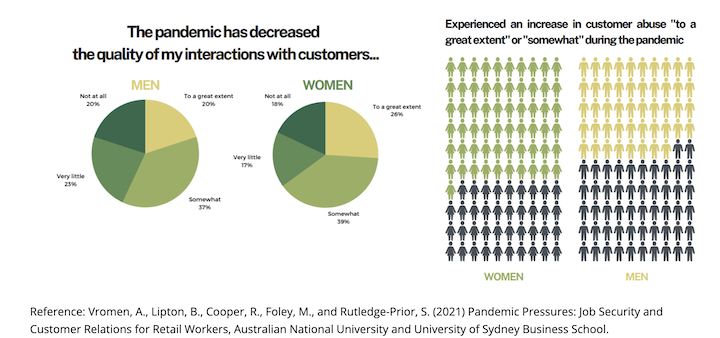It seems like we are being asked for de-escalation training almost every day at the moment. Reports show increases in aggression as high as 400 per cent during Covid, however, the numbers are not decreasing. Our masks are off and the borders are open and consumers are as angry as ever.
For retailers, coming to work feels less safe, contributing to the flight of staff from front-line work. As well as being understaffed they have to deal with angry customers. Being verbally abused is one thing, however, now there are cases of physical abuse as well.
Some 88 per cent of retail workers experienced verbal abuse from a customer in the past year and 85 per cent of retail workers experienced verbal abuse while attempting to prevent theft. Employees who face dysfunctional customer behaviour experience lower job satisfaction, lower organisational commitment, higher absenteeism, and reduced morale and motivation.
“The majority of Australian retail workers agree that abuse and crime in the retail sector are reasons why retail staff look for other jobs,” said The National Retail Association in a statement in 2020.

What has happened to us?
In October 2021, Time Magazine published an article titled, “Why everyone is so rude right now”. The publication attributed the rise in bad behaviour to the pressures and stress that people have been under during the past two years as Covid wreaked havoc globally. Most of us were unprepared for the threat that Covid posed to us and our lifestyle. The extended time of the threat has had a damaging effect on people’s mental health. There has been an increase in anxiety, depression and increased demand for mental health services.
If you translate this into workplaces, and couple it with staff shortages and difficulties in product sourcing, many people in retail are experiencing escalating levels of stress.
And the pressure is further exacerbated by inflation and the rising cost of living.
Our coping mechanisms are not that well-oiled, and there is increasing substance abuse in our communities, as well as outbursts of verbal and physical abuse that we are just not used to seeing.
We just want everything to go back to ‘normal’.
There is an enormous amount of frustration and it’s being taken out on our front-line people.
So how can you keep your staff, your co-workers and yourself safe in the current environment?
There are some clear guidelines about dealing with escalating situations in-store and on the phone.
No one should have to be subjected to this type of behaviour, however, when you are, you need to have some tools and strategies that you can call on.
Here are four key tips to help your team:
- Situational awareness
Your ability to be aware of what’s going on around you is important in keeping you safe. By looking, listening and assessing the area around you, you are able to recognise threats as they arise.
If you can do that, you can take the appropriate action and keep yourself, your teammates and your customers safe.
Activate your senses, keep your head up and stay present. Remove things that distract you like your phone and earbuds, so that you can be aware of what’s going on around you.
- Assessing risk
Assess the risk by identifying things that trigger a red flag response in you. Most of us have a great instinct for danger if we tune into it. Look for things that are out of the ordinary. Is a person dressed inappropriately for the environment? Is their behaviour unusual? Is their body language unexpected?
Be careful about your bias here and be aware that it’s easy to profile people based on the way they look.
- Strategies to prevent escalation
If you assess that the person’s behaviour may be a risk and you feel safe, you can approach your customer. Often a friendly approach and the offer of some help will be enough to diffuse the situation.
Use a genuine and gentle smile, and try to keep calm when you approach, avoiding staring at the person which can seem confrontational. Ask open-ended questions that encourage them to talk.
Psychologists suggest that people slow down, breathe out more slowly and lower their voices when encountering difficult social situations or irate people so as not to make any situation worse. “All anger management involves pausing,” observed Time last year.
- Knowing when to back off
If your customer does not visibly calm down or change their behaviour then you should distance yourself, your team and your customers.
Take two steps back, and if there is something like a box, trolley or counter close, stand behind it to give everyone space.
If the customer continues to move towards you, try holding your hand up (like a stop sign) and firmly ask the customer to step back.
If you feel unsafe, threatened or intimidated at any stage, you should back off and get help. That might be in the form of a security guard or phoning the police.
Always remember that stock and fittings can be replaced, it is not worth compromising your safety to protect it.
De-escalation training
At RedSeed we have just launched de-escalation programs as part of our online content library.
RedSeed.com is an online learning ecosystem with seriously good content for customer experience teams. If we do not have it in our library, we can make it for you. And you can use it on your platform or ours.
- Video-based course library.
- Build knowledge and change behaviour.
- Integrated manager-led coaching.
- Simply, powerful LMS.







